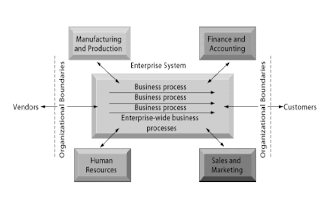
Enterprise Resource Planning (ERP) System
A large organization typically has many different kinds of information systems that support differentfunctions, organizational levels, and business processes. Managers might have a hard time assembling the data they need for a comprehensive, overall picture of the organization’s operations. That mean managers don’t have enough time to get information from difference information system.Enterprise systems, also known as Enterprise Resource Planning (ERP) systems solve this problem by providing a single information system for the organization.
Enterprise systems integrate the key business processes of sale, production, finance and humanresource into a single software system that enables information to flow seamlessly throughout the organization. These systems primarily focus on internal
processes but may include transactions with customers and vendors.
The enterprise system collects data from various key business processes in manufacturing and production, finance and accounting, sales and marketing, and human resources and stores the data in a single comprehensive data storage place.
For Example :
When a sales representative in Brussels enters a customer order, the data flows automatically to others in the company who need to see them. The factory in Hong Kong receives the order and begins production. The warehouse checks its progress online and
schedules the shipment date.
The system also automatically recalculates the company’s balance sheets, accounts receivable and payable ledgers, cost-center accounts, and available cash.

No comments:
Post a Comment